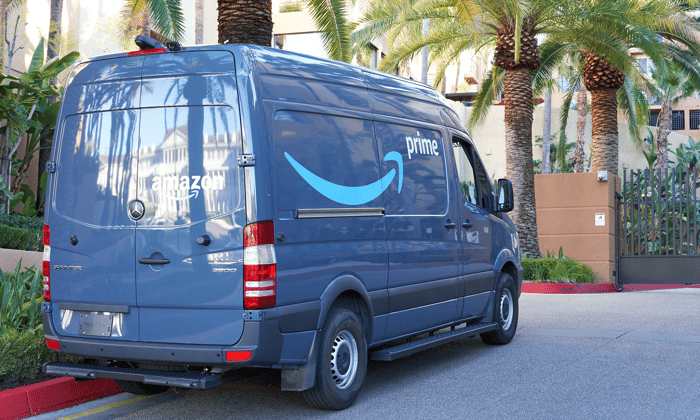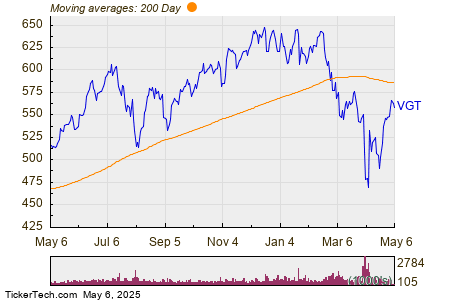Amazon’s Q1 Outlook: Pricing Strategies Amid Economic Challenges
Ahead of Amazon‘s (NASDAQ: AMZN) first-quarter earnings report, investor anxiety was palpable. This concern is justified, as tariffs and a slowing economy may impact the company’s e-commerce operations.
Prior to its report, a Wall Street analyst suggested that Amazon might “eat price” to stave off market share loss. The company is forecasting sales in line with Wall Street expectations, but it anticipates operating income will fall short. Amazon emphasized the critical importance of maintaining low prices during these challenging times.
Amazon also pointed out that its extensive third-party seller network offers a range of prices. Additionally, the company has taken strategic steps, such as stockpiling inventory in anticipation of tariffs. Overall, Amazon aims to navigate various economic conditions while focusing on customer experience.

Image source: Amazon.
Amazon clarified that it is “not uniquely susceptible” to tariffs. All large-scale retailers will face similar pressures. While the tariff situation is temporary, consumers will eventually adapt. By keeping prices low and focusing on swift delivery, Amazon is positioned to capture retail market share over the long term.
AWS Remains Amazon’s Major Growth Driver
While investors are keeping a close eye on Amazon’s e-commerce segment, its cloud computing division, Amazon Web Services (AWS), continues to be its most profitable and fastest-growing sector. AWS reported a 17% year-over-year revenue increase to $29.3 billion and a 22% rise in operating income to $11.5 billion. However, AWS revenue slightly missed the $29.42 billion anticipated by analysts from StreetAccount.
The company is investing heavily in data center infrastructure to meet rising AI demands and believes there’s significant potential to transition companies from on-premise solutions to the cloud. Currently, 85% of global IT spending is still on-premises, which Amazon expects to shift toward cloud solutions over the next 10 to 20 years.
AWS continues to promote its custom AI chips, asserting that its Trainium 2 chips deliver a 30% to 40% better price performance compared to similar graphics processing units. Still, Amazon remains committed to offering clients a choice between multiple chip providers.
On the consumer front, Amazon’s North American sales grew 8% to $92.9 billion, while international sales increased by 5%, or 8% when adjusted for constant currencies, reaching $33.5 billion. Operating income for North America rose 16% to $5 billion, with the international segment showing a slight increase to $1 billion from $0.9 billion last year.
Advertising services have also seen robust growth, with revenue up 19% to $13.92 billion, exceeding the $13.74 billion analyst consensus from StreetAccount. The company noted that its full-funnel advertising solutions are resonating with brands, further boosting high-margin revenue for its e-commerce segments.
Revenue from third-party seller services increased by 7% to $36.5 billion, while online store revenue climbed 6% to $57.4 billion. Sales from physical stores, including Whole Foods and Amazon Fresh, grew 5% to $5.5 billion. Additionally, revenue from subscription services rose 11% to $11.7 billion.
Overall, Amazon’s total revenue increased by 9% to $155.7 billion, marginally surpassing the $155 billion consensus from analysts at LSEG. Adjusted earnings per share skyrocketed 62% to $1.59, exceeding analyst predictions of $1.36.
For the quarter, Amazon generated $113.9 billion in operating cash flow and $25.9 billion in free cash flow, indicating a healthy cash position despite its heavy investment in AI infrastructure.
Looking ahead, Amazon forecasted Q1 revenue between $159 billion and $164 billion, representing a growth rate of 7% to 11%. Operating income is expected in the range of $13 billion to $17.5 billion, compared to $14.7 billion last year. Analysts anticipated operating income of $17.6 billion (StreetAccount) on revenue of $160.9 billion (LSEG).

Image source: Getty Images.
Long-Term Growth Perspective for Amazon Stock
Amazon has successfully navigated different economic landscapes over the years. Although tariffs and economic pressures may pose short-term challenges, they are unlikely to alter the company’s long-term growth path.
While its e-commerce sector continues to expand, Amazon’s drive for efficiency through AI enhances its profitability. Additionally, its ascendancy as one of the world’s leading digital advertising platforms is contributing to a robust stream of high-margin revenue.
AWS remains Amazon’s primary growth engine, exhibiting ample potential due to AI advancements and the ongoing transition from on-premise systems to the cloud. The introduction of custom AI chips offers a further cost advantage to the company.
Trading at a forward price-to-earnings (P/E) ratio of approximately 25 based on 2025 analyst estimates positions Amazon among the most attractively valued companies in its history. This scenario presents a favorable opportunity for investors to acquire shares in this long-term growth company.
Learn more about investment opportunities »
John Mackey, former CEO of Whole Foods Market, an Amazon subsidiary, is a member of The Motley Fool’s board of directors. Geoffrey Seiler has no positions in any of the stocks mentioned. The Motley Fool has positions in and recommends Amazon. The Motley Fool has a disclosure policy.
The views and opinions expressed herein are those of the author and do not necessarily reflect those of Nasdaq, Inc.


